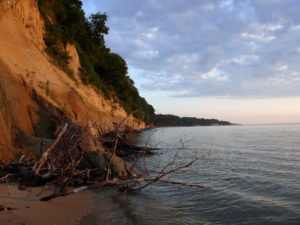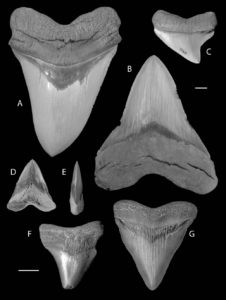 Calvert Marine Museum Curator of Paleontology, Dr. Stephen J. Godfrey, has edited a multi-authored volume published today. Smithsonian Contributions to Paleobiology no. 100, “The Geology and Vertebrate Paleontology of Calvert Cliffs, Maryland, USA,” is online at https://opensi.si.edu/index.php/smithsonian/catalog/book/107. This website has links to access and download the PDF file at no cost.
Calvert Marine Museum Curator of Paleontology, Dr. Stephen J. Godfrey, has edited a multi-authored volume published today. Smithsonian Contributions to Paleobiology no. 100, “The Geology and Vertebrate Paleontology of Calvert Cliffs, Maryland, USA,” is online at https://opensi.si.edu/index.php/smithsonian/catalog/book/107. This website has links to access and download the PDF file at no cost.
Calvert Cliffs, along the Western shore of the Chesapeake Bay, ranks high among the best-known fossil deposits of any age. The Miocene epoch fossils range from 8-22 million years old. The fossils preserved in these cliffs give us an understanding of what it was like in the Miocene world. One that included,
among many others, crocodiles and the mega-tooth shark megalodon. More than 600 kinds of organisms have been identified. The last comprehensive review of the fossil vertebrates from Calvert Cliffs was published more than 100 years ago. This new publication is a collection of papers that updates some of

“Calvert Cliffs at Warrior’s Rest Sanctuary; view looking north. These 12-15
million-year-old sediments from the Miocene epoch preserve fossils of marine organisms. Photo by
Stephen J. Godfrey. Courtesy Smithsonian Institution Scholarly Press.”
the geological features of Calvert Cliffs and provides reviews of fossil sharks, skates, rays, fishes, crocodiles, and sea cows.
Peter Vogt, Ralph R. Eshelman, and Stephen J. Godfrey describe how the 65–130 foot high Calvert Cliffs provide information about the Miocene geology, the marine and terrestrial vertebrate fauna, and the origin and evolution of the Chesapeake Bay and Calvert Cliffs up to the present time.
Bretton W. Kent describes the cartilaginous fish fauna, consisting of 54 species—3 ratfishes, 39 sharks, and 12 skates and rays—a fauna rich in large predatory sharks and large neritic rays. In an addendum to Kent’s chapter, he and David J. Ward describe a new species of giant thresher shark with serrated teeth.
Giorgio Carnevale and Stephen J. Godfrey review 38 bony fish species. These fishes are adapted for life in a well-oxygenated sea floor dominated primarily by shallow-water species and secondarily by species preferring the sunlit zone of the ocean.
Robert E. Weems details the crocodilians that belong to the genus Thecachampsa, whose closest living relative is the false gharial of Southeast Asia (Tomistoma schlegelii). Two species are present: Thecachampsa sericodon and T. antiquus. The fossils of these crocodilians are found in shallow marine
coastal deposits, indicating that they inhabited coastal waters.

“FIGURE 2.14 from Bretton Kent’s chapter on the fossil sharks found along
Calvert Cliffs. Various Carcharocles megalodon teeth. Photos by Karen Nelson Kent. Courtesy
Smithsonian Institution Scholarly Press.”
Daryl P. Domning reports that fossils of the Miocene marine fauna include rare sea cows of the family Dugongidae. Three taxa are known of these herbivorous marine mammals: Metaxytherium crataegense, Nanosiren sp., and, aff. Corystosiren.
This publication is dedicated to the landowners along Calvert Cliffs and other tributaries flowing into the Chesapeake Bay, who have generously allowed professional paleontologists to quarry fossils from their cliff-front properties. Permission to quarry is only half the equation, however. The majority of the finds along the cliffs are made by amateur/avocational collectors; they donate many of their finds to public museum collections—principally those of the Calvert Marine Museum (CMM) and the Smithsonian Institution’s National Museum of Natural History. Seventy percent of the fossils in the permanent paleontology collection at CMM were donated by avocational paleontologists. Most of the fossils illustrated in this publication were also collected by amateurs. The dedication of this volume is also extended to include avocational collectors, for without their generosity, this publication would not be complete. “We hope that both amateur and professional paleontologists will enjoy this publication. I thank God, the contributing authors, CMM artist Tim Scheirer for his illustrations throughout, and the editors at SISP…I’m standing on the shoulders of giants!” said Stephen Godfrey.
For more information on the paper, please contact Stephen Godfrey at 410-326-2042, ext. 28 or email [email protected]..


